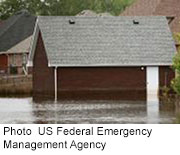
FRIDAY, Nov. 2 (HealthDay News) — Millions more in the storm-ravaged Northeast woke up Friday morning to restored electricity as the region slowly recovers from “superstorm” Sandy.
But the U.S. death toll from the storm climbed to 92 by Friday as more bodies were recovered from wrecked and flooded homes, the Associated Press reported.
Overall, 3.8 million people remain without power, down from a peak of 8.5 million, the AP said.
Cities and towns hit hard by Sandy had begun to restore power and transportation Wednesday and early Thursday. In New York City, officials reopened the Stock Exchange after a two-day shutdown, airports began to resume service and theater lights went on once more. Partial service has been restored to New York City’s subway system.
Sandy — which started as a hurricane until being dubbed a post-tropical cyclone Tuesday — made landfall near Atlantic City, N.J., Monday evening.
Millions have seen power restored to their homes, but the AP reported Friday that 1.3 million people across New York State were without power. In New Jersey, more than 1.6 million people are without electricity, as are 372,000 in Pennsylvania, 241,000 in Connecticut, more than 104,000 in West Virginia and just under 89,000 in Ohio.
Heavy snowfall in states such as Kentucky, West Virginia and Maryland are adding to power outages. In West Virginia, Governor Earl Ray Tomblin requested a federal disaster declaration after nearly three feet of snow fell in that state.
Eqecat, a company that predicts the costs of catastrophes for insurance companies, said Sandy’s economic damage could total $10 billion to $20 billion, the Washington Post reported.
For the millions still without power, preparation will have been key, said one expert.
Dr. Robert Glatter, an emergency medicine physician at Lenox Hill Hospital in New York City, said it’s important to have stockpiles of prescription medicines, special medical supplies, nonperishable foods — baby formula and pet foods, too — as well as emergency essentials.
“Be prepared to be self-sufficient for one to five days without access to grocery stores,” Glatter said.
Experts also advised that local authorities must be told about any elderly, disabled or bedridden people who might need emergency assistance. Find out where your community’s emergency shelters are.
If you evacuate, Glatter said it’s important to have a ready-made kit or “go bag,” including extra eyeglasses, sanitized baby bottles and diapers. People with diabetes should keep extra insulin on hand and a ready supply of snacks in case their sugar levels drop, he said. Store insulin or any liquid antibiotics on ice or cold packs during power failures, he suggested.
Patients who use a CPAP machine for sleep apnea or chronic obstructive pulmonary disease (COPD) may need an alternative power source during the storm. This includes a CPAP battery pack, he said.
To be on the safe side, assemble a one- to two-week supply of prescription medications, Glatter said. And “stay connected — have a list of your doctors with their contact information.”
Keep emergency phone numbers near every phone and in your cellphone “contacts” list.
“Have coins and cash available, too,” Glatter said.
In terms of hurricane supplies, the U.S. Centers for Disease Control and Prevention suggested the following:
- Three to five days’ worth of water, about five gallons per person, in clean containers and three to five days’ worth of nonperishable food.
- Well-stocked first-aid kits for your home and car. The car also needs maps, food, blankets and basic tools such as pliers and tape.
- Charged cellphones, flashlights, a battery-powered radio and extra batteries.
- Extra blankets or sleeping bags.
- Soaps, toothpaste and other personal hygiene necessities. Also, paper towels or baby wipes for personal cleaning if showering or bathing isn’t possible.
- Water-purifying supplies such as chlorine or iodine tablets or unscented household chlorine bleach.
- A fire extinguisher that all in the family know how to use.
More information
The U.S. Centers for Disease Control and Prevention has more about emergency preparedness.

